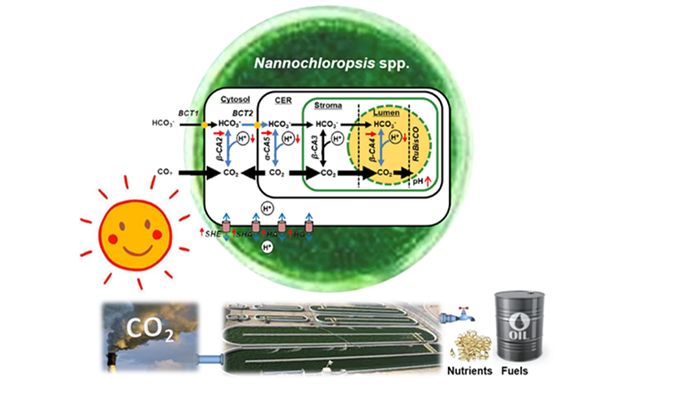The rapid elevation of atmospheric carbon dioxide level has led to global warm and ocean acidification. Microalgae, which together account for nearly 40% of global carbon dioxide fixation on Earth, have found themselves on the forefront of mankind’s battle against climate change, since many of them are able to directly convert sunlight and industrial carbon dioxide stream into transportation fuels such as biodiesels and energy-rich nutrients such as triacylglycerols.
However, the high concentration of carbon dioxide in flue gases, typically higher than 5% v/v, would lead to acidification of culture media. This outcome, while reducing the chance of contamination by nutrient competitors such as bacteria, would generally inhibit the growth of industrial microalgae. Therefore, reducing the so-called ‘CO2 poisoning effect’, i.e., improving the tolerance to high level of CO2, has become one priority in the development of super microalgae for carbon fixation.
In a new study published on Metabolic Engineering, a team of scientists led by Professor XU Jian from Qingdao Institute of Bioenergy and Bioprocess Technology (QIBEBT), Chinese Academy of Sciences (CAS), China has developed a way to improve the tolerance to high level of CO2 in the industrial oil-producing microalgae Nannochloropsis.

Fig: Mechanisms for the higher acidity tolerance in the CA2-knockdown N. oceanica
(Image by WEI Li)
The research team started by discovered CA2, a key enzyme of the Carbon Concentrating Mechanism (CCM), as a key sensor of the extracellular CO2 level. Then instead of enhancing the function of the sensor, the team reduced its activity by RNAi-based gene knockdown. Surprisingly, the mutants are able to grow 30% faster than the wild-type cells under the 5% CO2 level in flue gas, which is over 100 times higher than the 0.04% CO2 level found in the air. Moreover, this advantage is persistent under various types of photobioreactors and a wide range of cultivation scales.
In the ancient times, the atmospheric CO2 level on Earth was many times higher than that of today. As a result, over millions of years of evolution, the CCMs of microalgae, whose role was to concentrate the CO2 molecules around the prevalent carbon fixing machinery called RuBisCO, have had to gradually adapt to the lower and lower level of CO2 in the atmosphere. Therefore, the research team, by down-regulating the CCM activity, essentially turned back the clock of this evolution process and returned the modern-day CCM to its ancient, high-CO2-accustomed form. This “anti-evolution” endeavor by the scientists thus greatly improves the microalga’s tolerance to high CO2 environments, such as that found in flue gases.
This novel strategy has general implications to the development of industrial oil-producing microalgae as well as food crops, under circumstances where high carbon levels are beneficial or even necessary. These circumstances can arise not only in the industrial conversion of flue gas for reducing carbon emission and mitigating global warm, but also in mankind’s space exploration hunting for the next homes. For example, in Mars, which due to its short distance to the Earth is the most promising planet to serve as mankind’s second home, the level of CO2 is as high as 95%. Thus changing this hostile atmosphere to a human-friendly one like the one on Earth is a must before the Mars can be called home. Therefore, engineered microalgae, such as these CO2-consuming, O2-producing and fuel and lipid producing Nannochloropsis species that flourished under the exceedingly high level of CO2, can serve as the first generation of Mars immigrants, to carry the pioneering mission of transforming the CO2-rich atmosphere of Mars into a O2-rich one. In fact, inside these tiny and almost invisible green plants might actually find some of the most sought-after secrets to the human race’s bright destiny.